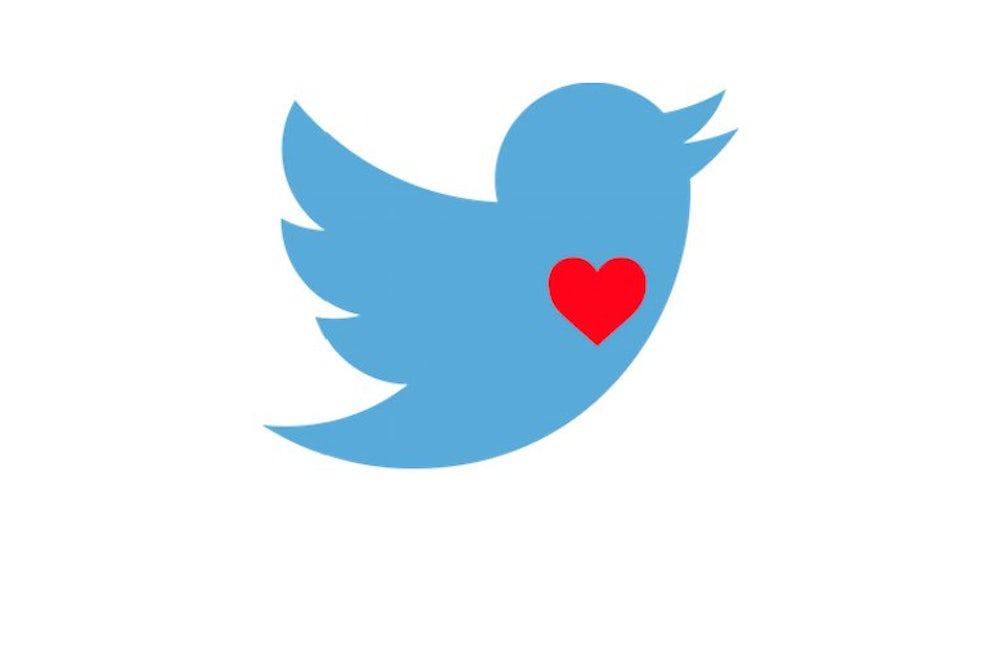If you happened to be on Twitter today and came across a tweet you wanted to favorite, you might have been surprised when your modest, neutral nod of approval suddenly transformed into a throbbing red heart bursting with rainbow glitter. Why the change? In a completely daft blog post this morning, Twitter staff explained that while the platform’s gold star icon “could be confusing” at times, the shimmering heart “is a universal symbol that resonates across languages, cultures, and time zones.”
If you had trouble discerning what people three hours ahead of you meant when they added mysterious gold stars to your tweets, your trials are over. Favorites are a thing of the past; we are now living in the age of the heart-shaped glitterbomb “like.”
Twitter’s decision to move from fave to like and star to heart has not been met with universal approval. Journalists who cover extremely grave topics and rely on Twitter to share their work are understandably concerned that a confetti-pulsing love note won't always be appropriate. Activists who have long pressured Twitter to add new security or privacy features to prevent harassment and abuse are understandably disappointed that the company evidently poured time into animating a new icon instead of developing a new safety feature. The heart also subtracts some of the neutrality present in the star: while someone might use the star to simply bookmark a tweet they intend to return to, a heart, especially one showered in multicolored sparkles, carries decidedly different connotations.
Twitter claims the heart contains a multitude of meanings, including“yes!”, “congrats”, “LOL”, “adorbs”, “stay strong”, and “wow.” Of course, like all icon indicators on the internet, meanings are both abundant and impoverished. A Facebook “like” hardly covers the spectrum of emotional responses to events in the world (nor do I usually want to thumbs-up someone’s distressing life update). A Reddit “upvote,” on the other hand, is ambiguous enough to signal agreement or a belief that others should see something, or perhaps neither. Twitter’s heart, like the star before it, will also say too much and not enough.
You can say a lot with a heart. Introducing a new way to show how you feel on Twitter: https://blog.twitter.com/2015/hearts-on-twitter ... pic.twitter.com/G4ZGe0rDTP
—
twitter
Most people on Twitter probably don’t use the platform the way members of the media do, and it certainly makes more sense to slap a twinkling heart onto a family member’s daily status update than a tweet linking to a story of horrific human rights abuses. Twitter was probably thinking of its broader user base, rathern than its concentrated media constituency, when it made the change. Or maybe it is just screwing with us.
But the heart has at least one advantage, in my view, besides allowing us to give truly spectacular tweets their due in one easy, throbbing click. One of the more enlightening aspects of passive internet use is that so many of our emojis, emoticons, and memes are imported from sectors of the global population we might otherwise never have intimate contact with. Exposure to the expressions of different groups can, incidentally, widen one’s own emotional vocabulary. Sometime during my early days of web use I encountered, for example, “OTL” or “orz”, which are profile images of a stick figure on hands and knees in total defeat. The emoji is reportedly of Asian origin, and it bundles together a host of feelings that, in the West, are not usually associated with half-humorously crumbling to the floor: despair, exhaustion, defeat, despondency, failure. Now when I experience those emotions (constantly) I have a way to instantly communicate them, instead of settling for a frown emoji. New expressions, in other words, help us understand new ways of feeling and communicating about what we feel. They enlarge our emotional vocabulary.
And they also give us insight into the emotional registers of other people. The heart, which Twitter suggests is more universal than a star, seems to me to actually be less so. It has more in common with emoticons used mostly by young women, like the red, fluttering Tumblr heart (which also signals a “like”). In that sense—and in a very small way—the glittering heart infuses into popular, mainstream discourse a way of communicating that is more often than not denigrated as silly and frivolous. For some, especially those not accustomed to heart-y levels of enthusiasm, the button may even offer a new way of feeling. (Which seems ridiculous, until one considers that the Facebook ‘like’ has spread beyond its original platform to other parts of the internet, and is also percolating into real-life communication and art. Life imitates the internet.)
Furthermore, the heart’s ironic use seems to fit well with the "lol nothing matters" ethos of the internet at large, meaning that if you're not in the market for a fancy new mode of self-expression, you can still use it to communicate that all of this is meaningless, which may just make this the most versatile icon ever used on Twitter.
For these reasons I welcome the heart, and will be indiscriminately hearting tweets for the next several weeks. Welcome to the future.
